Document Parameters > Document > 3D Fragment |
  
|
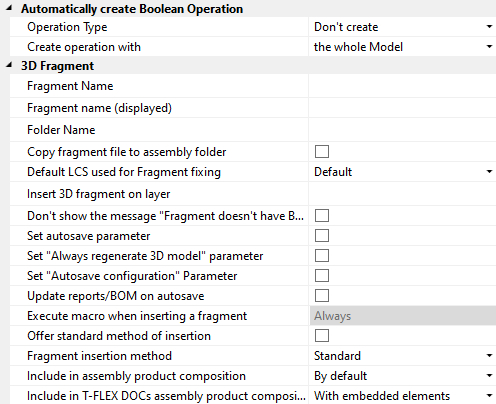
3D fragment tab in Set Model Parameters command provides possibility to specify default LCS used for fragment fixing, specify type of insertion, set parameters for automatic Boolean operation.
Automatically create Boolean Operation
When inserting a 3D fragment, one can automatically create a Boolean operation of a specified type. The target body will be the selected body in the assembly, while the tool body - one of the bodies of the 3D fragment, or all fragment bodies at once.
Setting up automatic creation of Boolean operation is performed with the help of several parameters:
Operation Type. This parameter defines the type of the Boolean operation (addition, subtraction, intersection) that will be created upon inserting the fragment in the assembly. The type can be selected from the list.
Create operation with:
•Use the whole Model. With this option checked, the whole 3D model of the fragment will be used as the target body of the Boolean operation.
•Use single operation. Selecting this option makes the Boolean use just a single operation within the fragment. The desired operation can be selected from the list of all existing operations.
In the case when a body is used in the Boolean, that is not visible when working with the document of the 3D fragment, it is possible to place it in a special layer marked as Visible only when model is used as a Fragment.
Let's take an example of the use of automatic creation of a Boolean operation when inserting a fragment. Suppose there is a 3D model of the wall of the house in which you need to insert a window as a 3D fragment.
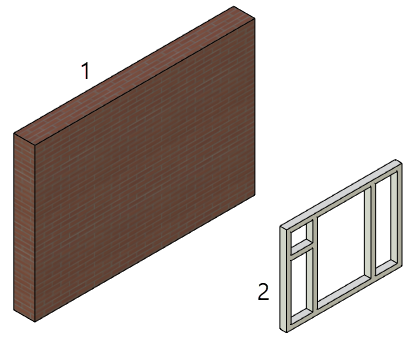
1. House wall model
2. Window model in a separate fragment
To do this, the window model must be created in a certain way. You need to specially create a parallelepiped body on top of the window, along which an opening in the wall will be cut to insert the window.
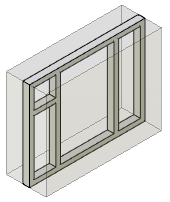
Then you need to open the document parameters, the 3D Fragment tab (see above). Set the Operation Type - Subtraction, Create operation with - operation of creating a parallelepiped body (for example, Extrusion_2).
Then you need to go to the fragment with the model of the wall of the house, call the fragment insertion command, insert the window fragment into the desired location and click ![]() .
.
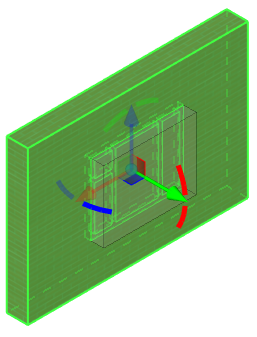
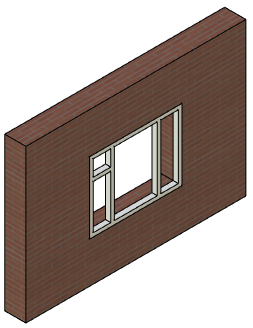
As a result, the inserted window fragment will be subtracted from the model of the house wall.
3D Fragment
Fragment Name. Non-associative name to be used for displaying a 3D fragment operation in 3D model tree, upon inserting the current document into assembly. Variables are not supported. By default, when using this name, it is followed in the tree by the path to the fragment document in parentheses.
Fragment name (displayed). Associative name to be used for displaying a 3D fragment operation in 3D model tree, upon inserting the current document into assembly. Variables can be used for defining this parameter. A name of a variable should be put into curve braces (e.g.: {$name}). By default, when using this name, the path to the fragment document is not displayed in the tree.
Thus, following fragment name configurations are possible:
If both parameters (Fragment Name and Fragment name (displayed)) are not specified, then, upon inserting the current document into an assembly, the 3D fragment operation will have default name (3D Fragment_#, where # - index number of the operation). In the 3D model tree the fragment will be represented by this name followed by the path to the fragment document in parentheses.
If only the Fragment Name parameter is specified, then, upon inserting the current document into an assembly, the 3D fragment operation will have the name assigned via the following pattern: Fragment Name_#, where # - index number of the operation. In the 3D model tree the fragment will be represented by this name followed by the path to the fragment document in parentheses.
If only the Fragment name (displayed) parameter is specified, then, upon inserting the current document into an assembly, the 3D fragment operation will have default name (3D Fragment_#, where # - index number of the operation). In the 3D model tree the fragment will be represented by the value of the Fragment name (displayed) parameter without index number and path.
If both parameters (Fragment Name and Fragment name (displayed)) are specified, then, upon inserting the current document into an assembly, the 3D fragment operation will have name assigned via the following pattern: Fragment Name_#, where # - index number of the operation. In the 3D model tree the fragment will be represented by the value of the Fragment name (displayed) parameter without index number and path.
The format of displaying fragment names in the 3D model tree can be customized using the Appearance... command, which is available in the ![]() tree parameters menu.
tree parameters menu.
Folder Name. This parameter specifies the name of the folder into which the fragment will be placed in the assembly’s model tree.
Fragment’s name and folder’s name are read from the fragment’s file only upon creation of the new fragment. If the values of these parameters are changed, then upon update of the fragment in the assembly the name and the folder will remain the same.
Copy fragment file to assembly folder. If this parameter is turned on, the file of a fragment that is inserted into the assembly is automatically copied into the folder of the assembly document (or its subfolder). A link to the file that has been copied and not to the original one is written in the properties of the fragment.
You can specify a name for the subfolder to the right of the flag. The subfolder will be created inside the folder of the assembly document into which the file of the fragment will be copied. If this field is empty, the file is copied directly into the folder of assembly.
Default LCS used for Fragment fixing is selected from the list. The list contains all local coordinate systems of the model that have the flag “Use for Fragment insertion” set. When inserting such document as a 3D fragment, the thus defined coordinate system will be automatically offered as the source LCS.
If necessary, the permitted degrees of freedom can be set in the properties of the prepared coordinate system, which will insure the correct behavior of the given 3D fragment in an assembly in the mode of moving mated elements (see the chapter Mates and degrees of freedom).
For uncomplicated parts, which can be conveniently inserted into the assembly in the mode of dynamic snapping, the given mode can be turned by default.
Insert 3D fragment on layer. This parameter defines the name of the layer onto which the fragment will be placed upon its insertion into the assembly. If in the fragment’s document the “Insert on layer” parameter is enabled, but upon insertion of the fragment into the assembly this layer does not yet exist, then this layer is created automatically upon request.
Don’t show the message “Fragment doesn’t have bodies”. By default this parameter is disabled. In this case the system does not allow for insertion, into the 3D assembly, of the fragment in which the 3D model is absent or suppressed. The corresponding message in the diagnostics window appears as comments. When this flag is enabled the system allows for insertion of “empty” fragment without issuing any messages.
Set Autosave Parameter. If the given parameter is set up, then upon insertion of the current document as a 3D fragment into the assembly, the “Auto Save” parameter is automatically enabled in the parameters of the fragment. The file of such a fragment will automatically be saved upon each saving of the assembly, with the substitution of the values of external variables and adaptive parameters.
Set "Always regenerate 3D model" parameter. Enables the Always Recalculate 3D Model and Auto Updated Projections checkbox in parameters of 2D fragment. If it's enabled, 3D model of a fragment and those of its 2D projections, that have auto update enabled, are automatically recalculated upon linked 2D fragment's parameters alteration.
Set "Autosave configuration" Parameter. Modifies configuration/variation in fragment file when changing variable values.
Update reports/BOM on autosave. Enable this checkbox, then insert the current document into an assembly as 3D fragment and enable the Autosave checkbox in fragment's parameters. In result, upon each autosave all reports and BOMs existing in the fragment document will be updated.
Execute macro when inserting a fragment. Depending on its value, when using the “Smart Fragment, Macro” insertion method (see below), macros can be auto-executed:
•Only for 2D,
•Only for 3D,
•Always.
Offer standard method of insertion. If the checkbox is enabled, then, instead of launching a macro immediately upon fragment’s insertion, the system will invoke a dialog, where you can choose between executing a macro and standard insertion.
Fragment insertion method. The chosen way defines behavior of a 3D fragment at an insert into 3D assembly.
•Standard. Upon insertion into the assembly the translation of the fragment is possible only with the help of the manipulator of LCS (dynamic translation is disabled);
•Fastener. When inserted into the assembly the fragment dynamically moves after the cursor of the mouse;
•3D Placement. This method of insertion is used for quick creation of the arrangement in 3D scene. In the fragment’s file special attachments to the floor, walls, ceiling, horizontal surfaces must be created. These attachments are defined by means of connectors with the specific parameters;
•By three points. A fragment can be fixed to the selected in the 3D scene points upon insertion. Its size changes according to the distance between the points.
•Smart fragment, Macro. This method of insertion is used for parametric fragments whose insertion scenario is described in the program (macro) stored directly in the file of the given fragment or in the external module (DLL). When inserting the file as a fragment the user-specified macro will be executed.
Include in assembly product composition. The drop-down list contains following options: By default, Don't include, Without embedded elements, With embedded elements, Embedded elements only. The selected option will be applied automatically in the fragment parameters (Additional Parameters > Include in new Product Composition) upon inserting this document into an assembly. The By default option applies the parameter that is set as default for all fragments within the assembly document (via the By default checkbox in fragment's parameters dialog).
Include in T-FLEX DOCs assembly product composition. Same as above, except this parameter is used, when inserting a fragment into DOCs assembly within the integration mode. If the integration is disabled, this parameter is not displayed.
Moreover, the 3D Fragment tab contains following sub-tab: